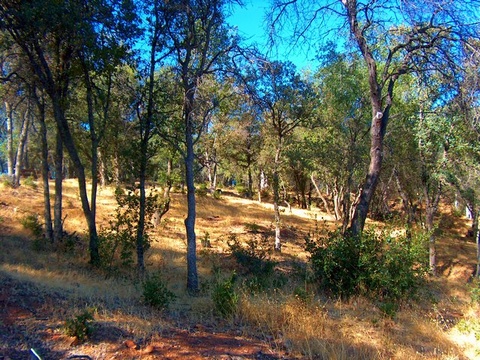 Blue oak woodland in Hammon Grove Park. Some of the native shrub understory survives, but the native herbaceous plants have been largely replaced by non-native annual invasive weeds, which are the reason California's characteristic "golden hills" are their well-known shade of golden brown for so much of the year. Photo by queerbychoice. Central oak woodland is the plant community native to most of Sutter and Yuba Counties. Specifically, it covers all land below approximately 1,600 feet in Yuba County (above that is yellow pine forest), and all land above approximately 50 feet in Sutter County (below that is valley grassland)1—and except for wetlands in both counties (which are part of the riparian forest or in some cases, freshwater marsh). It is defined by a predominance of oak trees.
Blue oak woodland in Hammon Grove Park. Some of the native shrub understory survives, but the native herbaceous plants have been largely replaced by non-native annual invasive weeds, which are the reason California's characteristic "golden hills" are their well-known shade of golden brown for so much of the year. Photo by queerbychoice. Central oak woodland is the plant community native to most of Sutter and Yuba Counties. Specifically, it covers all land below approximately 1,600 feet in Yuba County (above that is yellow pine forest), and all land above approximately 50 feet in Sutter County (below that is valley grassland)1—and except for wetlands in both counties (which are part of the riparian forest or in some cases, freshwater marsh). It is defined by a predominance of oak trees.
A synonym for central oak woodland is "foothill woodland," although this name is somewhat misleading. The plant community in question does cover much of the foothills, but it also covers covers much of California's central valley—or it once did, before cities were built in the valley and many of the native plants were removed. Alemandra, Arboga, Beale Air Force Base, Berg, Bogue, Browns Valley, Dantoni, Daugherty Hill State Wildlife Area, District 10, East Arboga, Encinal, Frenchtown, Hallwood, Hammonton, Horstville, Iowa City, Linda, Live Oak, Loma Rica, Marigold, Marysville, Mello, Mount Vernon, Olive Hill, Olivehurst, Oregon House, Ostrom, Pearson, Pennington, Rackerby, Ramirez, Rancho Loma Rica, Sanders, Sicard Flat, Smartsville, South Yuba, South Yuba City, Spenceville State Wildlife Area, Stanfield Hill, Sullivan, Sunset, Sutter, the Sutter Buttes, Tambo, Tierra Buena, West Butte, West Linda, Wheatland, and Yuba City are all in central oak woodland.
Central oak woodland manifests itself somewhat differently at different elevations and with differing groundwater supplies. In general, groundwater supplies tend to be more ample at lower elevations. In the Sacramento Valley, the oak trees are often primarily valley oaks, which are the least drought-tolerant of the native oak trees. Areas where valley oaks predominate are sometimes called valley oak woodland. Valley oaks, blue oaks, interior live oaks, Frémont's cottonwoods, blue elderberries, toyon, California coffeeberries, California wild grapes, Pacific blackberries, and poison oak are all very common in valley oak woodland. The Frémont's cottonwoods, blue elderberries, California wild grapes, and Pacific blackberries are found in the spots with the most ample supply of groundwater, while the blue oaks, interior live oaks, toyon, and California coffeeberries are found in slightly drier spots.2 (Unfortunately, poison oak grows throughout all central oak woodland areas and all of Yuba and Sutter Counties, regardless of water supply. Sorry!) The soil in valley oak woodland is typically clay, with high fertility but poor drainage.
In the foothills or where the groundwater supply is especially sparse, the oak trees are primarily blue oaks, because these are the most drought-tolerant of the native oak trees. Areas where blue oaks predominate are sometimes called blue oak woodland. Blue oaks, gray pines, interior live oaks, California buckeyes, Western redbuds, blue elderberries, common manzanitas, buckbrush, yerba santa, silver bush lupine, California coffeeberries, redberries, rock gooseberries, and poison oak are all very common in blue oak woodland. Blue oak woodland occurs across a range of elevations in the foothills, but gray pines, interior live oaks, yerba santa, and rock gooseberries are found in greater numbers at the higher elevations within the blue oak woodland's range.3 The soil in blue oak woodland may be red clay or sandy loam. Because the ground is often sloped in the foothills, the drainage is typically better in blue oak woodland than in valley oak woodland.
Wherever the groundwater supply is exactly right for the species of oak growing there, the oak trees may grow so closely that most of them touch each other, and there may be a significant number of shrubs growing beneath them; this is sometimes referred to as oak forest. Where the groundwater supply is less appropriate for the species of oak growing there, the oak trees will be widely spaced, with very few or no shrubs growing beneath them; this is sometimes referred to as oak savannah.
Throughout California, much of the native understory in central oak woodland areas has been largely replaced by invasive weeds—primarily annual grasses. These non-native annual grasses are the reason California's characteristic "golden hills" are their well-known shade of golden brown for so much of the year. Before the arrival of Europeans, the ground beneath the oaks contained far fewer annual grasses and was instead dominated by the wildflowers listed below, supplemented occasionally with the grasses listed below—many of which do not die or turn brown in late summer, but instead turn a dull blue-green to conserve water until the winter rains arrive.
Oak tree seedlings rarely sprout or survive in the presence of non-native weeds. As a result of the non-native annual grasses having replaced so much of their understory, the oak trees in central oak woodland areas throughout California are no longer replacing themselves as quickly as they die off. If nothing is done to help them, central oak woodland will largely disappear within the next century. The ecosystem's health, stability, and beauty can be greatly improved by removing the invasive grasses and planting native plants. The plants listed below are native to central oak woodland in Yuba and/or Sutter Counties.4
Trees
Oaks
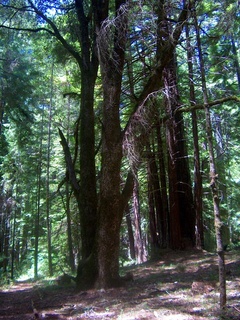 Canyon live oak (Quercus chrysolepis). Photo by queerbychoice. (See the Oaks page for more information about these and other oak species.)
Canyon live oak (Quercus chrysolepis). Photo by queerbychoice. (See the Oaks page for more information about these and other oak species.)
canyon live oak* (also called gold cup oak or maul oak)
valley oak (also called California white oak)
*not typically found in valley oak woodland
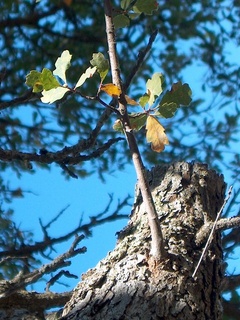 The small, shallowly lobed leaves of blue oak (Quercus douglasii) in Hammon Grove Park. Photo by queerbychoice.
The small, shallowly lobed leaves of blue oak (Quercus douglasii) in Hammon Grove Park. Photo by queerbychoice. 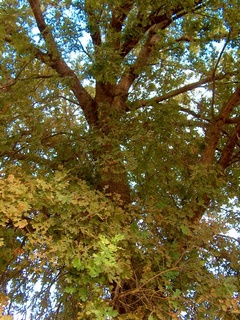 Valley oak (Quercus lobata) in Beckwourth Riverfront Park Complex. Photo by queerbychoice.
Valley oak (Quercus lobata) in Beckwourth Riverfront Park Complex. Photo by queerbychoice. 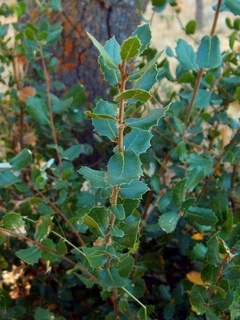 The holly-like leaves of interior live oak (Quercus wislizeni) in Hammon Grove Park. Photo by queerbychoice.
The holly-like leaves of interior live oak (Quercus wislizeni) in Hammon Grove Park. Photo by queerbychoice.
Other Trees
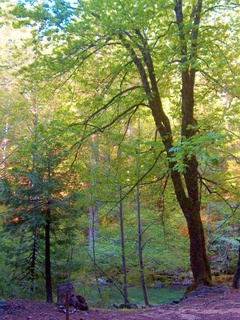 Bigleaf maple (Acer macrophyllum) on the Feather River Little North Fork, north of Strawberry Valley. Photo by queerbychoice. (See the Conifers and Native Edible Fruits pages for more information about some of these species.)
Bigleaf maple (Acer macrophyllum) on the Feather River Little North Fork, north of Strawberry Valley. Photo by queerbychoice. (See the Conifers and Native Edible Fruits pages for more information about some of these species.)
California buckeye (also called California horse chestnut)
flowering ash* (also called foothill ash or two-petal ash)
gray pine* (also called foothill pine or bull pine)
*not typically found in valley oak woodland
 Pacific madrone (Arbutus menziesii) in the California State University Sacramento arboretum. Photo by queerbychoice.
Pacific madrone (Arbutus menziesii) in the California State University Sacramento arboretum. Photo by queerbychoice. 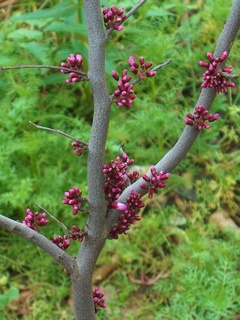 In February, pink buds cover the bare trunk of a Western redbud (Cercis occidentalis) in a garden in Marysville. Photo by queerbychoice.
In February, pink buds cover the bare trunk of a Western redbud (Cercis occidentalis) in a garden in Marysville. Photo by queerbychoice. 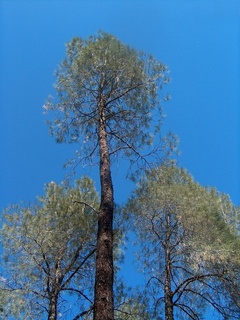 Gray pines (Pinus sabiniana) in Hammon Grove Park display characteristically rounded tops, with mostly bare trunks below. Photo by queerbychoice.
Gray pines (Pinus sabiniana) in Hammon Grove Park display characteristically rounded tops, with mostly bare trunks below. Photo by queerbychoice. 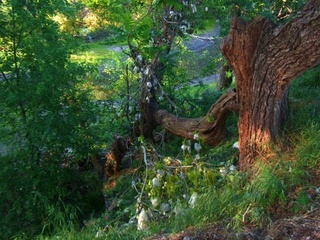 Frémont's cottonwood (Populus fremontii) in the American River Parkway, with cotton-like seeds. The tree is named for John C. Frémont. Photo by queerbychoice.
Frémont's cottonwood (Populus fremontii) in the American River Parkway, with cotton-like seeds. The tree is named for John C. Frémont. Photo by queerbychoice. 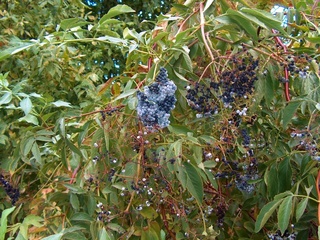 Blue elderberry (Sambucus mexicana) in Beckwourth Riverfront Park Complex. The unripe berries have a white coating; the coating slowly wears away as the berries ripen. Photo by queerbychoice.
Blue elderberry (Sambucus mexicana) in Beckwourth Riverfront Park Complex. The unripe berries have a white coating; the coating slowly wears away as the berries ripen. Photo by queerbychoice. 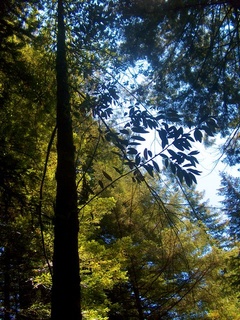 California bay laurel (Umbellularia californica). Photo by queerbychoice.
California bay laurel (Umbellularia californica). Photo by queerbychoice.
Shrubs
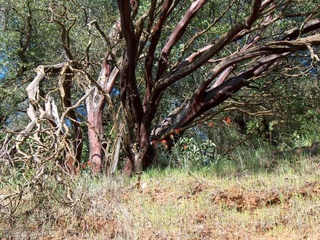 Common manzanita (Arctostaphylos manzanita) in Auburn State Recreation Area, with paintbrushes beneath it. Photo by queerbychoice. (See the California Lilacs, Buckwheats, Beardtongues, Lupines, Buckthorns, Native Edible Fruits, and Roses pages for more information about some of these species.)
Common manzanita (Arctostaphylos manzanita) in Auburn State Recreation Area, with paintbrushes beneath it. Photo by queerbychoice. (See the California Lilacs, Buckwheats, Beardtongues, Lupines, Buckthorns, Native Edible Fruits, and Roses pages for more information about some of these species.)
spicebush (also called sweet shrub)
buckbrush* (also called wedgeleaf California lilac)
yerba santa* (also called mountain balm)
stretchberry (also called desert olive or spring goldenglow)
white pitcher sage* (also called woodbalm)
silver bush lupine (also called evergreen purple lupine)
rock gooseberry** (also called oak gooseberry)
dwarf rose* (also called wood rose)
*not typically found in valley oak woodland
**not typically found east of the Sutter Buttes
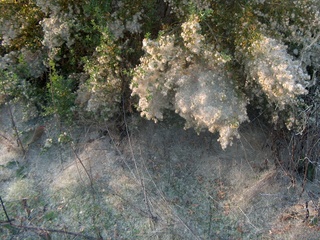 Coyote brush (Baccharis pilularis) shrubs are plentiful on the other sides of all the levees surrounding Marysville. In winter, the female coyote brushes are easy to spot by the way they cover the ground with a snow-like layer of fluffy, white seeds. Photo by queerbychoice.
Coyote brush (Baccharis pilularis) shrubs are plentiful on the other sides of all the levees surrounding Marysville. In winter, the female coyote brushes are easy to spot by the way they cover the ground with a snow-like layer of fluffy, white seeds. Photo by queerbychoice. 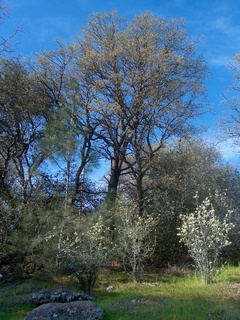 Several buckbrush (Ceanothus cuneatus) shrubs bloom with white flowers under oak and pine trees near Smartsville. Photo by queerbychoice.
Several buckbrush (Ceanothus cuneatus) shrubs bloom with white flowers under oak and pine trees near Smartsville. Photo by queerbychoice.  Lemmon's California lilac (Ceanothus lemmonii) blooming with blue flowers, accompanied by red paintbrushes and a young yellow pine tree. Photo by queerbychoice.
Lemmon's California lilac (Ceanothus lemmonii) blooming with blue flowers, accompanied by red paintbrushes and a young yellow pine tree. Photo by queerbychoice. 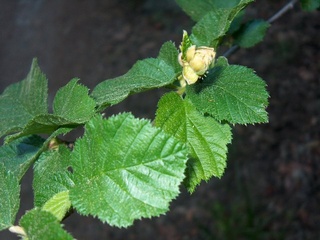 California hazelnut (Corylus cornuta) near Strawberry Valley. Photo by queerbychoice.
California hazelnut (Corylus cornuta) near Strawberry Valley. Photo by queerbychoice. 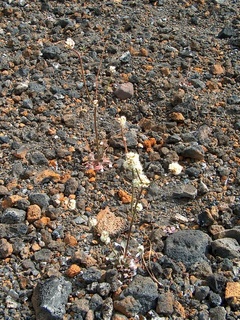 Naked buckwheat (Eriogonum nudum) is named for the fact that it has no leaves except for a few small ones at ground level. Photo by queerbychoice.
Naked buckwheat (Eriogonum nudum) is named for the fact that it has no leaves except for a few small ones at ground level. Photo by queerbychoice. 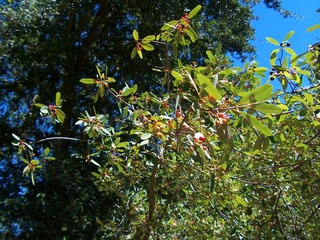 A California coffeeberry (Frangula californica) in the American River Parkway, laden with fruit. Photo by queerbychoice.
A California coffeeberry (Frangula californica) in the American River Parkway, laden with fruit. Photo by queerbychoice. 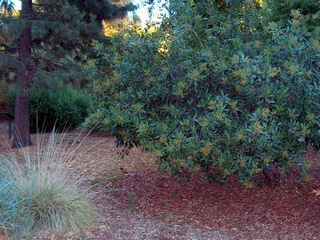 Toyon (Heteromeles arbutifolia) in the California State University Sacramento arboretum. The clusters of berries will turn bright red as they ripen. Photo by queerbychoice.
Toyon (Heteromeles arbutifolia) in the California State University Sacramento arboretum. The clusters of berries will turn bright red as they ripen. Photo by queerbychoice. 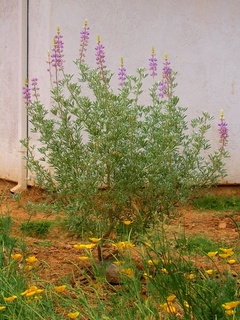 Silver bush lupine (Lupinus albifrons) in a garden in Marysville, with California golden poppies. Photo by queerbychoice.
Silver bush lupine (Lupinus albifrons) in a garden in Marysville, with California golden poppies. Photo by queerbychoice. 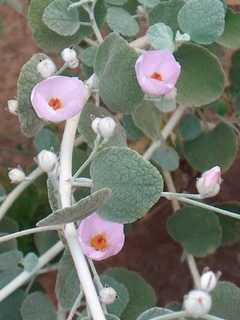 Frémont's bush mallow (Malacothamnus fremontii) blooms with pale pink flowers in a garden in Marysville. The shrub is named for John C. Frémont. Photo by queerbychoice.
Frémont's bush mallow (Malacothamnus fremontii) blooms with pale pink flowers in a garden in Marysville. The shrub is named for John C. Frémont. Photo by queerbychoice. 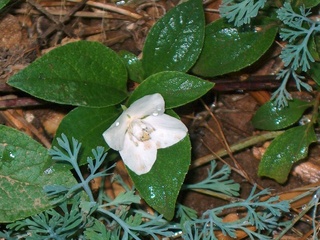 A single flower blooms on a ground-level branch of a young mock orange (Philadelphus lewisii) in a Marysville garden. Photo by queerbychoice.
A single flower blooms on a ground-level branch of a young mock orange (Philadelphus lewisii) in a Marysville garden. Photo by queerbychoice. 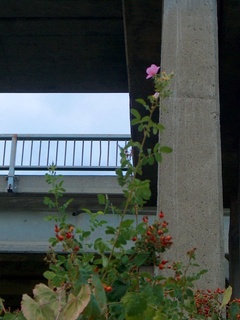 California wild rose (Rosa californica) under the 5th Street Bridge, with hips and one remaining flower in October. Photo by queerbychoice.
California wild rose (Rosa californica) under the 5th Street Bridge, with hips and one remaining flower in October. Photo by queerbychoice. 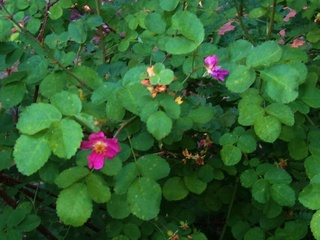 Dwarf wood rose (Rosa gymnocarpa) near Quincy. Photo by queerbychoice.
Dwarf wood rose (Rosa gymnocarpa) near Quincy. Photo by queerbychoice.
Vines
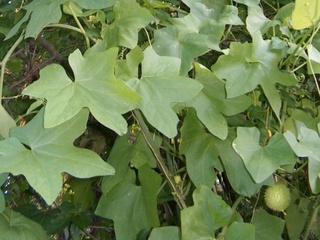 California manroot (Marah fabaceus) in the American River Parkway. Photo by queerbychoice. (See the Native Edible Fruits page for more information about some of these species.)
California manroot (Marah fabaceus) in the American River Parkway. Photo by queerbychoice. (See the Native Edible Fruits page for more information about some of these species.)
virgin's bower (also called Western creek clematis or yerba de chiva)
pink honeysuckle (also called California honeysuckle or hairy honeysuckle)
California manroot (also called wild cucumber)
Pacific blackberry (also called trailing blackberry)
*not typically found in valley oak woodland
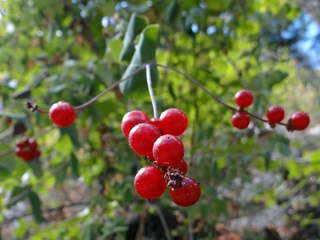 The berries of pink honeysuckle (Lonicera hispidula), shown here on the Feather Falls trail, are edible but have a very bitter aftertaste. Photo by queerbychoice.
The berries of pink honeysuckle (Lonicera hispidula), shown here on the Feather Falls trail, are edible but have a very bitter aftertaste. Photo by queerbychoice. 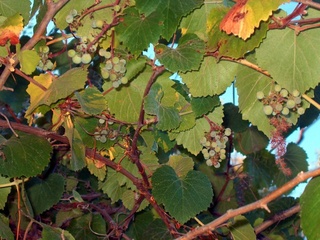 California wild grape (Vitis californica) in the small state wildlife area next to the Marysville City Cemetery. Photo by queerbychoice.
California wild grape (Vitis californica) in the small state wildlife area next to the Marysville City Cemetery. Photo by queerbychoice.
Herbaceous Perennials
Monocots
Grasses and Grasslike Plants
True Grasses
 California oniongrass (Melica californica) in a garden in Marysville. Photo by queerbychoice. (See the Ryegrasses and Oniongrasses pages for more information about some of these species.)
California oniongrass (Melica californica) in a garden in Marysville. Photo by queerbychoice. (See the Ryegrasses and Oniongrasses pages for more information about some of these species.)
squirreltail ryegrass* (also called bottlebrush rye grass)
creeping wild rye (also called valley wild rye, alkali rye, or beardless wild rye)
smallflower oniongrass** (also called coast range melic)
nodding needlegrass (also called nodding tussockgrass or nodding stipa)
purple needlegrass (also called purple tussockgrass or purple stipa)
pine bluegrass (also called one-sided bluegrass)
*not typically found in valley oak woodland **not typically found in blue oak woodland
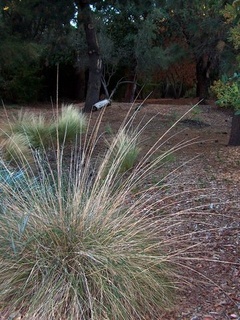 Deergrass (Muhlenbergia rigens) in the California State University Sacramento arboretum. Photo by queerbychoice.
Deergrass (Muhlenbergia rigens) in the California State University Sacramento arboretum. Photo by queerbychoice.
Sedges
 Valley sedge (Carex barbarae) in a garden in Marysville. Photo by queerbychoice. (See the Sedges page for more information about these and other sedge species.)
Valley sedge (Carex barbarae) in a garden in Marysville. Photo by queerbychoice. (See the Sedges page for more information about these and other sedge species.)
widefruit sedge* (also called narrowleaf sedge)
valley sedge (also called Santa Barbara sedge)
torrent sedge (also called naked sedge)
*not typically found in valley oak woodland
Rushes
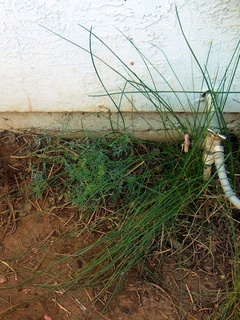 Wire rush (Juncus balticus) next to an outdoor faucet in Marysville. Photo by queerbychoice. (See the Rushes page for more information about these and other rush species.)
Wire rush (Juncus balticus) next to an outdoor faucet in Marysville. Photo by queerbychoice. (See the Rushes page for more information about these and other rush species.)
wire rush (also called Baltic rush)
common bog rush (also called soft rush)
poverty rush (also called slender rush)
*not typically found in valley oak woodland
Bulbs and Corms
Asparagus Family
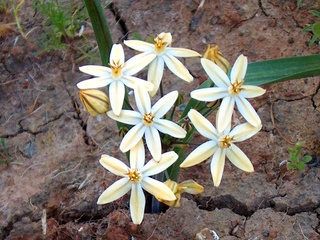 Golden prettyface (Triteleia ixioides) blooms in a garden in Marysville. Photo by queerbychoice. (See the Cluster-Lilies page for more information about these species.)
Golden prettyface (Triteleia ixioides) blooms in a garden in Marysville. Photo by queerbychoice. (See the Cluster-Lilies page for more information about these species.)
crown cluster-lily (also called early harvest cluster-lily)
harvest cluster-lily* (also called elegant cluster-lily)
dwarf cluster-lily* (also called vernal pool cluster-lily)
wild hyacinth (also called roundtooth ookow or many-flowered snakelily)
*not typically found in valley oak woodland
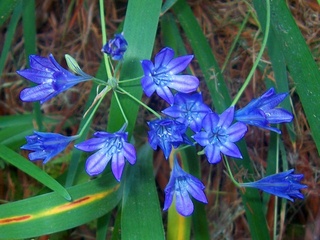 Ithuriel's spear (Triteleia laxa) is found in both Yuba and Sutter Counties. Photo by queerbychoice.
Ithuriel's spear (Triteleia laxa) is found in both Yuba and Sutter Counties. Photo by queerbychoice.
Lily Family
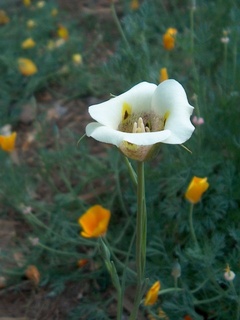 Superb mariposa tulip (Calochortus superbus) in a garden in Marysville, with California golden poppies. Photo by queerbychoice. (See the Tulips and Fritillaries pages for more information about some of these species.)
Superb mariposa tulip (Calochortus superbus) in a garden in Marysville, with California golden poppies. Photo by queerbychoice. (See the Tulips and Fritillaries pages for more information about some of these species.)
fairy lantern (also called white globe lily)
Sierra fawn lily* (also called adder's-tongue)
mission bells (also called checker lily)
*not typically found in valley oak woodland
Other Bulbs and Corms
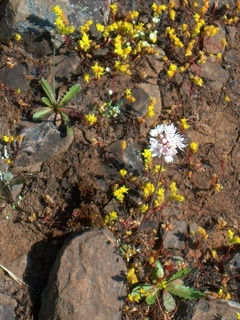 Narrowleaf onion (Allium amplectens) blooms on Table Mountain. Photo by queerbychoice. (See the Onions page for more information about some of these species.)
Narrowleaf onion (Allium amplectens) blooms on Table Mountain. Photo by queerbychoice. (See the Onions page for more information about some of these species.)
wavyleaf soaproot (also called amole)
bowltube iris (also called longtube iris or ground iris)
slender iris (also called longtube iris)
royal rein orchid (also called mountain rein orchid)
meadow death camas (also called meadow zigadene)
*not typically found in valley oak woodland
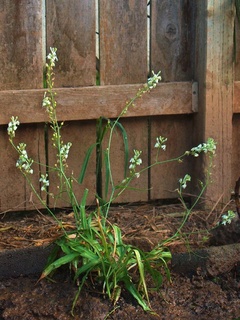 Hartweg's doll's lily (Odontostomum hartwegii) blooms in a garden in Marysville. Photo by queerbychoice.
Hartweg's doll's lily (Odontostomum hartwegii) blooms in a garden in Marysville. Photo by queerbychoice. 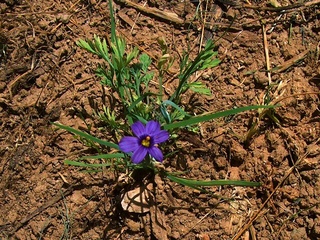 Blue-eyed grass (Sisyrinchium bellum) in a garden in Marysville. Photo by queerbychoice.
Blue-eyed grass (Sisyrinchium bellum) in a garden in Marysville. Photo by queerbychoice.
Dicots
Aster Family
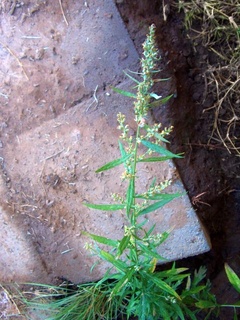 Mugwort (Artemisia douglasiana) in a garden in Marysville. Photo by queerbychoice. (See the Daisies and Mule Ears pages for more information about some of these species.)
Mugwort (Artemisia douglasiana) in a garden in Marysville. Photo by queerbychoice. (See the Daisies and Mule Ears pages for more information about some of these species.)
California balsamroot (also called big scale balsam root)
woolly sunflower (also called Oregon sunshine)
narrowleaf mule ears (also called California compassplant)
whitehead mule ears** (also called gray mule ears)
*not typically found in valley oak woodland
**not typically found in blue oak woodland
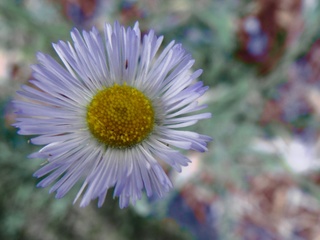 Diffuse daisy (Erigeron divergens) in a garden. Photo by queerbychoice.
Diffuse daisy (Erigeron divergens) in a garden. Photo by queerbychoice.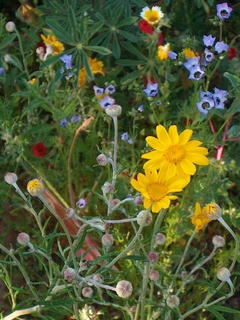 The yellow flowers and pinkish grey buds of woolly sunflower (Eriophyllum lanatum) mingle with tidytips, common goldfields, bird's eye gilyflower, and scarlet mallow in a Marysville garden. Photo by queerbychoice.
The yellow flowers and pinkish grey buds of woolly sunflower (Eriophyllum lanatum) mingle with tidytips, common goldfields, bird's eye gilyflower, and scarlet mallow in a Marysville garden. Photo by queerbychoice.  Serpentine sunflower (Helianthus bolanderi) blooms with the smaller flowers of rosillas (Helenium puberulum) in a Marysville garden. Photo by queerbychoice.
Serpentine sunflower (Helianthus bolanderi) blooms with the smaller flowers of rosillas (Helenium puberulum) in a Marysville garden. Photo by queerbychoice.  Telegraph weed (Heterotheca grandiflora) volunteers in a garden in Marysville. Photo by queerbychoice.
Telegraph weed (Heterotheca grandiflora) volunteers in a garden in Marysville. Photo by queerbychoice. 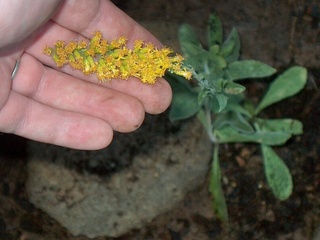 California goldenrod (Solidago californica) blooming in a Marysville garden. Photo by queerbychoice.
California goldenrod (Solidago californica) blooming in a Marysville garden. Photo by queerbychoice. 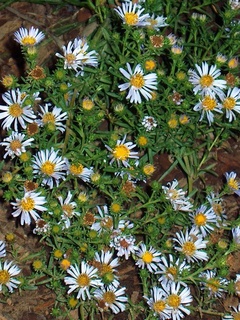 California aster (Symphyotrichum chilense) in a garden in Marysville. Photo by queerbychoice.
California aster (Symphyotrichum chilense) in a garden in Marysville. Photo by queerbychoice.
Buttercup Family
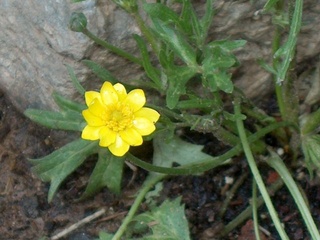 A California buttercup (Ranunculus californicus) blooming in a Marysville garden. Photo by queerbychoice. (See the Larkspurs and Buttercups pages for more information about these and other larkspur and buttercup species.)
A California buttercup (Ranunculus californicus) blooming in a Marysville garden. Photo by queerbychoice. (See the Larkspurs and Buttercups pages for more information about these and other larkspur and buttercup species.)
pine forest larkspur* (also called meadow larkspur)
red larkspur* (also called canyon larkspur)
spreading larkspur* (also called zigzag larkspur)
*not typically found in valley oak woodland
Other Plant Families
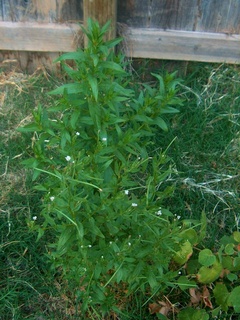 Fringed Northern willowherb (Epilobium ciliatum) volunteers in a garden in Marysville. Photo by queerbychoice. (See the Milkweeds, Paintbrushes, Willowherbs, Woodland Stars, Deervetches, Lupines, Coyote Mints, Beardtongues, Skullcaps, and Violets pages for more information about some of these species.)
Fringed Northern willowherb (Epilobium ciliatum) volunteers in a garden in Marysville. Photo by queerbychoice. (See the Milkweeds, Paintbrushes, Willowherbs, Woodland Stars, Deervetches, Lupines, Coyote Mints, Beardtongues, Skullcaps, and Violets pages for more information about some of these species.)
heartleaf milkweed* (also called purple milkweed)
kotolo milkweed* (also called Indian milkweed or woollypod milkweed)
narrowleaf milkweed* (also called Mexican whorled milkweed)
Franciscan paintbrush (also called longleaf paintbrush)
broadleaf shooting star (also called mosquito bills)
fringed Northern willowherb (also called slender willowherb)
Western wallflower (also called sand-dune wallflower or prairie rocket)
hillside woodland star** (also called hill star)
chaparral bird's foot trefoil* (also called bigleaf deervetch)
foothill beardtongue* (also called bunchleaf beardtongue)
gay beardtongue* (also called mountain blue beardtongue)
rock phacelia* (also called Kaweah River phacelia)
Sierra mint* (also called California mountain mint)
grayleaf skullcap* (also called curve-flowered skullcap)
checker mallow (also called wild hollyhock or dwarf checkerbloom)
*not typically found in valley oak woodland
**not typically found east of the Sutter Buttes
 The fluorescent orange of sand-dune wallflower (Erysimum capitatum) mingles with blue flax and arroyo lupine in a garden in Marysville. Photo by queerbychoice.
The fluorescent orange of sand-dune wallflower (Erysimum capitatum) mingles with blue flax and arroyo lupine in a garden in Marysville. Photo by queerbychoice. 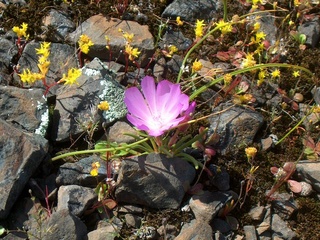 A single bitterroot (Lewisia rediviva) flower blooms among much smaller Pacific stonecrop flowers on Table Mountain. Photo by queerbychoice.
A single bitterroot (Lewisia rediviva) flower blooms among much smaller Pacific stonecrop flowers on Table Mountain. Photo by queerbychoice. 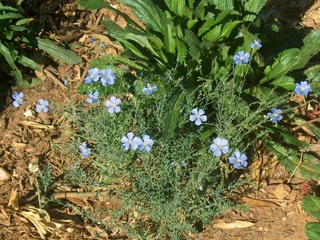 Blue flax (Linum lewisii) shows off its fine foliage and blue flowers against the broad leaves of chrysanthemums in a garden in Marysville. Photo by queerbychoice.
Blue flax (Linum lewisii) shows off its fine foliage and blue flowers against the broad leaves of chrysanthemums in a garden in Marysville. Photo by queerbychoice. 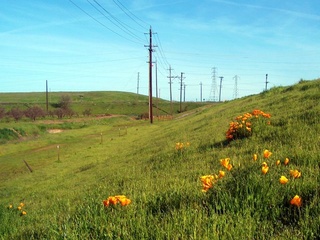 California golden poppies (Eschscholzia californica) growing wild on the Marysville levee. Photo by queerbychoice.
California golden poppies (Eschscholzia californica) growing wild on the Marysville levee. Photo by queerbychoice. 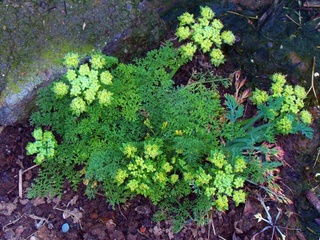 Woollyfruit lace parsnip (Lomatium dasycarpum) and a California golden poppy seedling in a garden in Marysville. Photo by queerbychoice.
Woollyfruit lace parsnip (Lomatium dasycarpum) and a California golden poppy seedling in a garden in Marysville. Photo by queerbychoice. 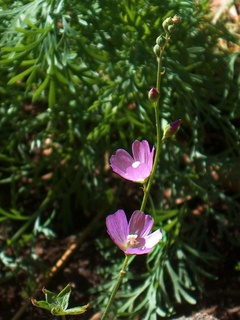 Checker mallow (Sidalcea malviflora) in a garden in Marysville. Photo by queerbychoice.
Checker mallow (Sidalcea malviflora) in a garden in Marysville. Photo by queerbychoice.
Ferns
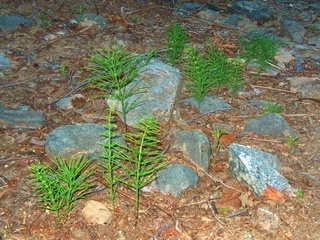 Field horsetail rush (Equisetum arvense) near Strawberry Valley. Photo by queerbychoice. (See the Maidenhair Ferns, Horsetails, and Wood Ferns pages for more information about these and other fern and horsetail species.)
Field horsetail rush (Equisetum arvense) near Strawberry Valley. Photo by queerbychoice. (See the Maidenhair Ferns, Horsetails, and Wood Ferns pages for more information about these and other fern and horsetail species.)
brittle bladderfern* (also called fragile fern)
coffee fern* (also called coffee cliffbrake)
bird's foot fern (also called bird's foot cliffbrake)
*not typically found in valley oak woodland
 Goldenback fern (Pentagramma triangularis) prefers full shade, as most ferns do. Photo by queerbychoice.
Goldenback fern (Pentagramma triangularis) prefers full shade, as most ferns do. Photo by queerbychoice. 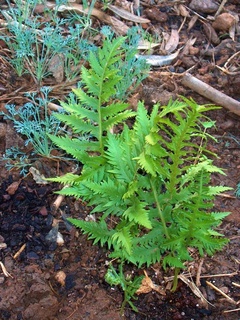 California polypody (Polypodium californicum) in a Marysville garden, with California poppy seedlings in the background. Photo by queerbychoice.
California polypody (Polypodium californicum) in a Marysville garden, with California poppy seedlings in the background. Photo by queerbychoice.
Annuals
Monocots
Grasses
prairie threeawn (also called oldfield three awn)
Dicots
Aster Family
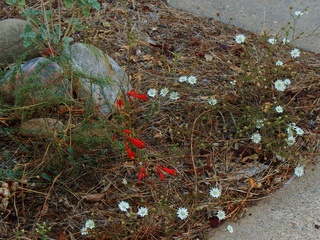 Hayfield tarweed (Hemizonia congesta) and California fuchsia in a garden in Marysville. Photo by queerbychoice. (See the Goldfields, Tarweeds, and Tidytips pages for more information about some of these species.)
Hayfield tarweed (Hemizonia congesta) and California fuchsia in a garden in Marysville. Photo by queerbychoice. (See the Goldfields, Tarweeds, and Tidytips pages for more information about some of these species.)
Fitch's spikeweed (also called Fitch's tarweed)
pitgland tarweed (also called narrow yellowflower tarweed)
California goldfields (also called common goldfields or valley goldfields)
gumweed tarweed (also called slender grassy tarweed)
slender cottontop (also called Q-tips)
tall rod wirelettuce (also called twiggy wreath plant)
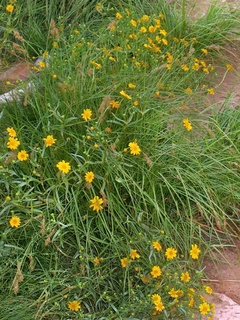 California goldfields (Lasthenia californica) mix with clustered field sedge in a garden in Marysville. Photo by queerbychoice.
California goldfields (Lasthenia californica) mix with clustered field sedge in a garden in Marysville. Photo by queerbychoice. 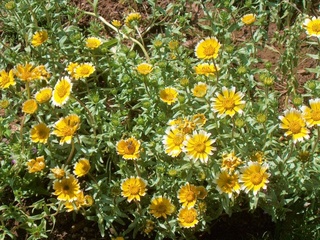 Common tidytips (Layia platyglossa) in a garden in Marysville. Photo by queerbychoice.
Common tidytips (Layia platyglossa) in a garden in Marysville. Photo by queerbychoice.
Borage Family
 Smallflower fiddleneck (Amsinckia menziesii) and unidentified popcornflowers on Table Mountain. Photo by queerbychoice. (See the Phacelias page for more information about some of these species.)
Smallflower fiddleneck (Amsinckia menziesii) and unidentified popcornflowers on Table Mountain. Photo by queerbychoice. (See the Phacelias page for more information about some of these species.)
small baby blue eyes (also called white canyon nemophila)
sleeping combseed (also called winged combseed)
common distant phacelia (also called wild heliotrope)
tansyleaf phacelia (also called lacy phacelia)
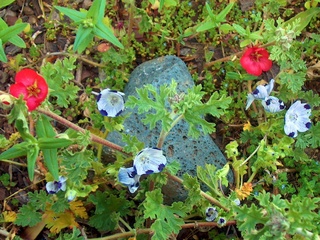 Five spot (Nemophila maculata) blooms in a garden in Marysville, along with non-native scarlet mallow. Photo by queerbychoice.
Five spot (Nemophila maculata) blooms in a garden in Marysville, along with non-native scarlet mallow. Photo by queerbychoice. 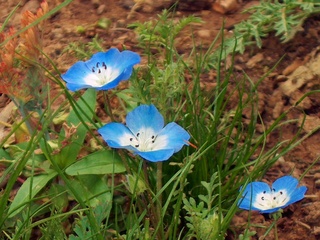 Baby blue eyes (Nemophila menziesii) bloom in a garden in Marysville. Photo by queerbychoice.
Baby blue eyes (Nemophila menziesii) bloom in a garden in Marysville. Photo by queerbychoice.
Mustard Family
sand fringepod (also called hairy lacepod)
ribbed fringepod (also called showy fringepod)
Pea Family
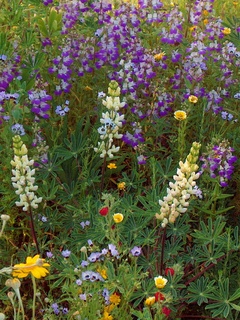 The pale yellow flower spikes of chick lupine (Lupinus microcarpus) mix with purple Chinese pagodas, bird's eye gilyflowers, yellowray goldfields, tidytips, woolly sunflower, and non-native scarlet mallow in a garden in Marysville. Photo by queerbychoice. (See the Deervetches, Lupines, and Clovers pages for more information about some of these species.)
The pale yellow flower spikes of chick lupine (Lupinus microcarpus) mix with purple Chinese pagodas, bird's eye gilyflowers, yellowray goldfields, tidytips, woolly sunflower, and non-native scarlet mallow in a garden in Marysville. Photo by queerbychoice. (See the Deervetches, Lupines, and Clovers pages for more information about some of these species.)
dwarf milkvetch (also called dwarf locoweed)
foothill deervetch (also called shortpod lotus or colchita)
desert deervetch (also called smallflower trefoil or San Diego lotus)
Chilean bird's foot trefoil (also called calf lotus)
chick lupine (also called valley lupine)
fatpod lupine (also called Mt. Diablo lupine or bigpod lupine)
arroyo lupine (also called hollowstem lupine or succulent lupine)
sour clover (also called bull clover)
pinpoint clover (also called graceful clover)
hairy maiden clover (also called smallhead field clover)
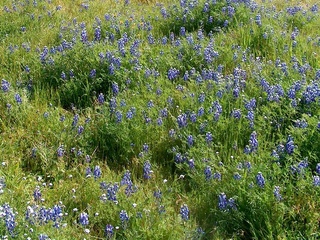 Sky lupine (Lupinus nanus) on Table Mountain. Photo by queerbychoice.
Sky lupine (Lupinus nanus) on Table Mountain. Photo by queerbychoice. 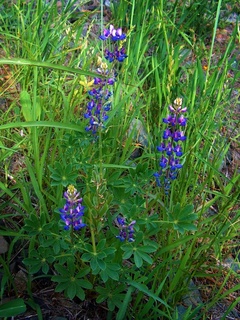 Arroyo lupine (Lupinus succulentus) on a levee in Marysville. Photo by queerbychoice.
Arroyo lupine (Lupinus succulentus) on a levee in Marysville. Photo by queerbychoice. 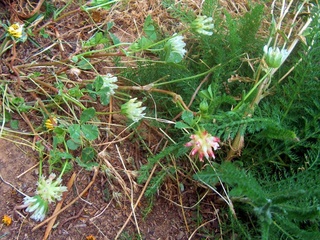 Sour clover (Trifolium fucatum) blooms in a garden in Marysville. Photo by queerbychoice.
Sour clover (Trifolium fucatum) blooms in a garden in Marysville. Photo by queerbychoice. 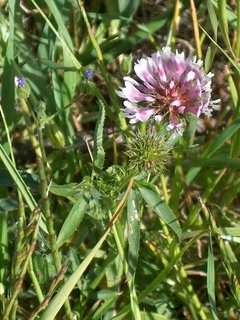 Tomcat clover (Trifolium willdenovii) in flower and bud on Table Mountain. Photo by queerbychoice.
Tomcat clover (Trifolium willdenovii) in flower and bud on Table Mountain. Photo by queerbychoice.
Mint Family
(See the Coyote Mints page for more information about some of these species.)
Evening-Primrose Family
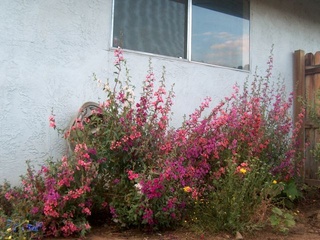 Mountain garland (Clarkia unguiculata) explodes in shades of pink, reddish purple, and white in early May in a garden in Marysville. Photo by queerbychoice. (See the Clarkias and Willowherbs pages for more information about some of these species.)
Mountain garland (Clarkia unguiculata) explodes in shades of pink, reddish purple, and white in early May in a garden in Marysville. Photo by queerbychoice. (See the Clarkias and Willowherbs pages for more information about some of these species.)
slender godetia (also called graceful farewell-to-spring)
winecup godetia (also called purple farewell-to-spring)
diamondpetal farewell-to-spring (also called forest farewell-to-spring)
mountain garland (also called elegant farewell-to-spring or woodland clarkia)
tall autumn willowherb (also called panicled willowherb)
denseflower willowherb (also called denseflower spike-primrose)
slender annual fireweed (also called little chaparral willowherb or minute desert willow herb]
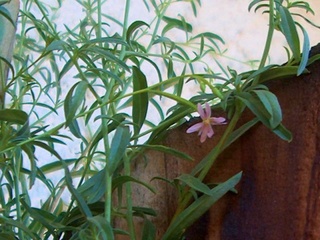 Tall autumn willowherb (Epilobium brachycarpum) blooms next to a six-foot-tall fence in Marysville. Photo by queerbychoice.
Tall autumn willowherb (Epilobium brachycarpum) blooms next to a six-foot-tall fence in Marysville. Photo by queerbychoice.
Broomrape Family
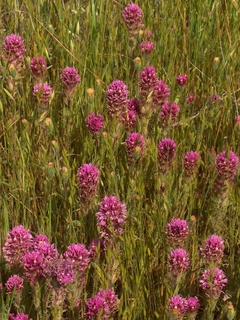 Purple owl's clover (Castilleja exserta) in Bear Valley. Photo by queerbychoice. (See the Paintbrushes page for more information about some of these species.)
Purple owl's clover (Castilleja exserta) in Bear Valley. Photo by queerbychoice. (See the Paintbrushes page for more information about some of these species.)
valley tassels (also called narrowleaf owl's clover)
cutleaf Indian paintbrush (also called foothill owl's clover)
valley tassels (also called sagebrush Indian paintbrush or thinlobe owl's clover)
butter 'n' eggs (also called johnnytuck)
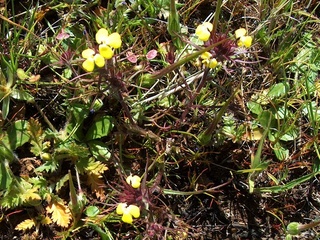 Butter 'n' eggs (Triphysaria eriantha) on Table Mountain. Photo by queerbychoice.
Butter 'n' eggs (Triphysaria eriantha) on Table Mountain. Photo by queerbychoice.
Plantain Family
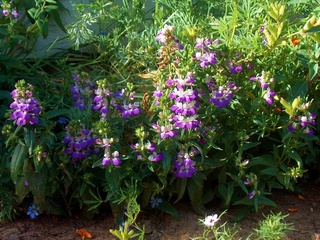 Purple Chinese pagodas (Collinsia heterophylla) in a garden in Marysville. Photo by queerbychoice. Brewer's sailflower snapdragon
Purple Chinese pagodas (Collinsia heterophylla) in a garden in Marysville. Photo by queerbychoice. Brewer's sailflower snapdragon
white blue-eyed Mary (also called white collinsia)
sticky Chinese houses (also called tincture plant)
Phlox Family
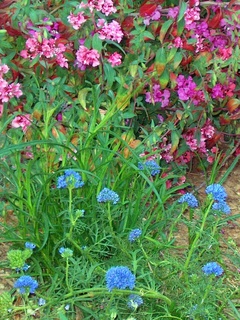 Globe gilyflower (Gilia capitata) and mountain garland in a garden in Marysville. Photo by queerbychoice. dense false gilyflower
Globe gilyflower (Gilia capitata) and mountain garland in a garden in Marysville. Photo by queerbychoice. dense false gilyflower
globe gilyflower (also called globe gilyflower)
downy pincushionplant (also called purple pincushionplant)
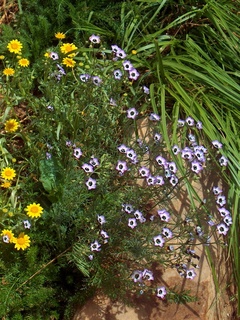 Bird's eye gilyflower (Gilia tricolor) and California goldfields in a garden in Marysville. Photo by queerbychoice.
Bird's eye gilyflower (Gilia tricolor) and California goldfields in a garden in Marysville. Photo by queerbychoice.
Knotweed Family
(See the Buckwheats page for more information about some of these species.)
Other Families
 Red maids (Calandrinia ciliata) bloom among river rocks at Parks Bar. Photo by queerbychoice. (See the Monkeyflowers page for more information about some of these species.)
Red maids (Calandrinia ciliata) bloom among river rocks at Parks Bar. Photo by queerbychoice. (See the Monkeyflowers page for more information about some of these species.)
charming centaury (also called canchalagua or beautiful centaury)
Contura Creek sandmat (also called Contura Creek spurge)
thymeleaf sandmat (also called thymeleaf spurge)
little serpentine springbeauty
chaparral dodder (also called California dodder)
common bluecup (also called Venus' looking glass)
common dwarf flax (also called smallflower Western flax or threadstem flax)
Douglas' stitchwort (also called Douglas' sandwort)
slender annual buttercup (also called delicate buttercup)
 The tiny, pale pink flowers of miner's lettuce (Claytonia perfoliata) bloom in a garden in Marysville. This plant is prized as a salad ingredient, generally sold only at high-end grocery stores. Growing your own is much cheaper than buying it from a grocery store! Photo by queerbychoice.
The tiny, pale pink flowers of miner's lettuce (Claytonia perfoliata) bloom in a garden in Marysville. This plant is prized as a salad ingredient, generally sold only at high-end grocery stores. Growing your own is much cheaper than buying it from a grocery store! Photo by queerbychoice. 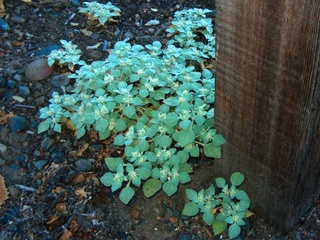 Doveweed (Croton setigerus) blooms next to a post in the American River Parkway. Photo by queerbychoice.
Doveweed (Croton setigerus) blooms next to a post in the American River Parkway. Photo by queerbychoice. 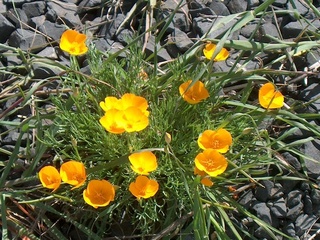 Foothill tufted poppy (Eschscholzia caespitosa) blooms in gravel on Table Mountain. This plant is closely related to the more familiar California poppy and looks like a miniature version of it (about half as big). Photo by queerbychoice.
Foothill tufted poppy (Eschscholzia caespitosa) blooms in gravel on Table Mountain. This plant is closely related to the more familiar California poppy and looks like a miniature version of it (about half as big). Photo by queerbychoice.
Footnotes
1. Las Pilitas Nursery: California Plant Communities by Zip Code
2. California Department of Fish and Game: Wildlife Habitats—California Wildlife Habitat Relationships System
3. California Department of Fish and Game: Wildlife Habitats—California Wildlife Habitat Relationships System
4. CalFlora.org


